Release 1.2
Part Number E36379-01
Contents
Previous
Next
| Oracle Pedigree and Serialization Manager Process Guide Release 1.2 Part Number E36379-01 | Contents | Previous | Next |
This chapter covers the following topics:
Before you can capture EPCIS events and post to the EPCIS repository or query the EPCIS repository you must first set up the EPCIS repository preferences, policies, and users. The EPCIS Capture web service and the EPCIS Query web service use this setup information during their processing of data.
For more information on the Capture and Query web services, see Web Services Overview.
Follow this high-level process flow to set up the EPCIS repository:
Set up EPCIS Preferences.
For more information, see Maintaining EPCIS Preferences.
Create EPCIS policies.
For more information, see Maintaining Policies.
Create EPCIS users.
For more information, see Maintaining Users.
Before you can begin to interact with the EPCIS repository you must first set up EPCIS preferences. Use the Maintain EPCIS Preferences page to define the preferences used by the EPCIS Capture web service when capturing and storing data in the EPCIS repository and the EPCIS Query web service when querying the EPCIS repository.
Use these procedures to view, set, and modify EPCIS preferences:
Navigate to the Maintain EPCIS Preferences page.
Maintain EPCIS Preferences page
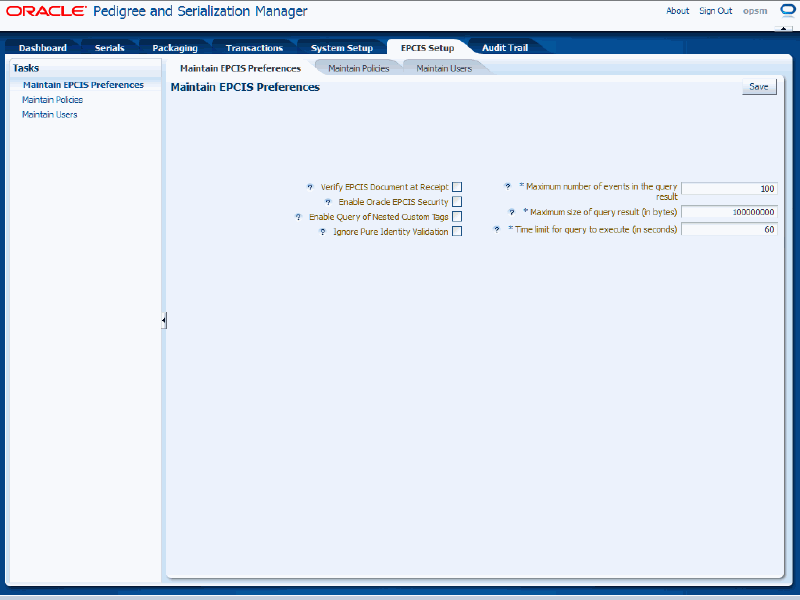
The Maintain EPCIS Preferences page appears displaying the current settings for the EPCIS preferences.
View the EPCIS preferences and their current settings.
Navigate to the Maintain EPCIS Preferences page.
Maintain EPCIS Preferences page
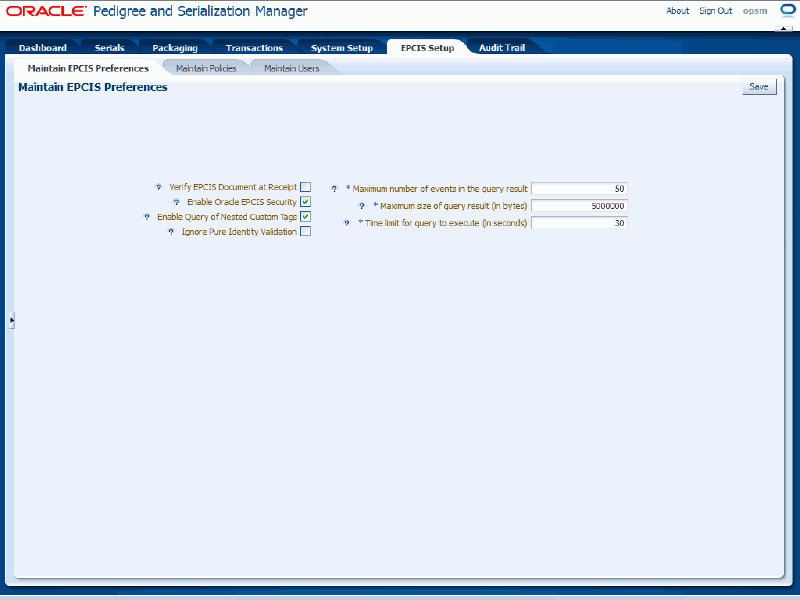
Select the settings for the following preferences:
| Field Name | Description |
|---|---|
| Verify EPCIS Document at Receipt check box | (Optional) Select this check box, if you want the EPCIS event sent into the EPC Capture web service to be validated against EPCglobal's XSD prior to any additional processing taking place.
Note: The event is always validated and this check box just controls the timing of that validation. If this check box is unchecked, and the format is invalid, the system will throw an error when it gets to the invalid section of the XSD. Having the validation happen up front can potentially increase performance. |
| Enable Oracle EPCIS Security check box | (Optional) Select this check box, if you want the system to check for EPCIS policies to verify that the user has access to the data being queried. |
| Enable Query of Nested Custom Tags check box | (Optional) Select this check box, if the system will allow the query of data in nested custom tags provided in the file extension. |
| Ignore Pure Identity Validation check box | (Optional) Select this check box, if you want the system to not validate that the EPC codes provided are in compliance with the GS1 standard. |
| Maximum number of events in the query result | Enter the number of events that can be returned in one query. If the number of events returned by the query exceeds this value, the result will not be returned. 50 appears by default. If you enter zero or a negative value upon saving the system will change the value back to the default value. Zero and negative values are not allowed. |
| Maximum size of query result (in bytes) | Enter the file size in bytes that can be returned in one query. If the size of the file exceeds this value, the result will not be returned. 50000000 appears by default. If you enter zero or a negative value upon saving the system will change the value back to the default value. Zero and negative values are not allowed. |
| Time limit for query to execute (in seconds) | Enter the allowed duration in seconds for processing a query. If the processing time exceeds this value, the result will not be returned. 30 appears by default. If you enter zero or a negative value upon saving the system will change the value back to the default value. Zero and negative values are not allowed. |
Navigate to the Maintain EPCIS Preferences page.
Modify any of the preferences.
Click the Save button.
Use the Maintain Policies page to define the policies used by the EPCIS Query web service when querying the EPCIS repository. You only have to set up policies if the Enable Oracle EPCIS Security check box is selected on the Maintain EPCIS Preferences page. These policies determine which data an external user has the ability to access through the EPCIS Query web service.
Use these procedures to search (basic and advanced), create, edit, and delete policies:
To Search for Policies (Basic Search)
Navigate to the Maintain Policies page.
Maintain Policies page (Basic Search)
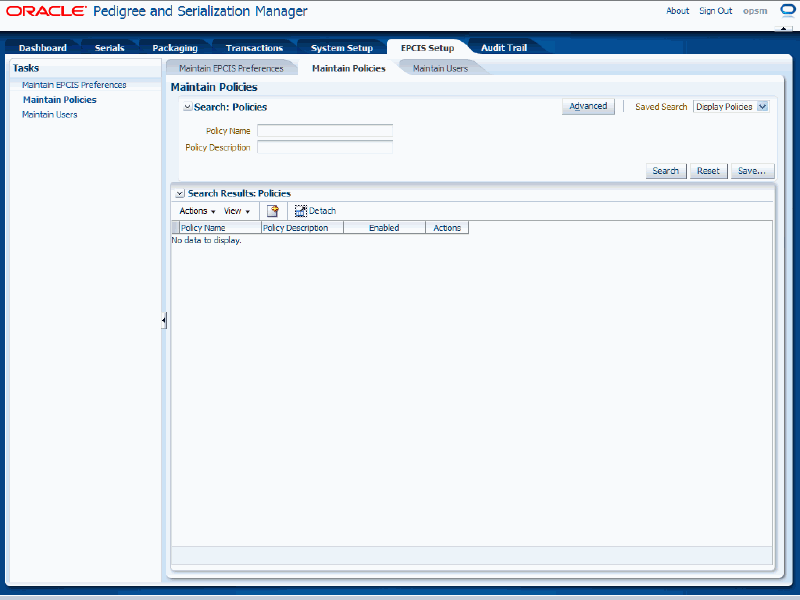
In the Search: Policies region, enter the search criteria for the policies using one or both of these fields:
| Field Name | Description |
|---|---|
| Policy Name | (Optional) Enter the policy name. |
| Policy Description | (Optional) Enter the policy description. |
Otherwise, you can click the Search button without entering any search criteria and all available policies will appear
Click the Search button.
Maintain Policies page (Basic Search)
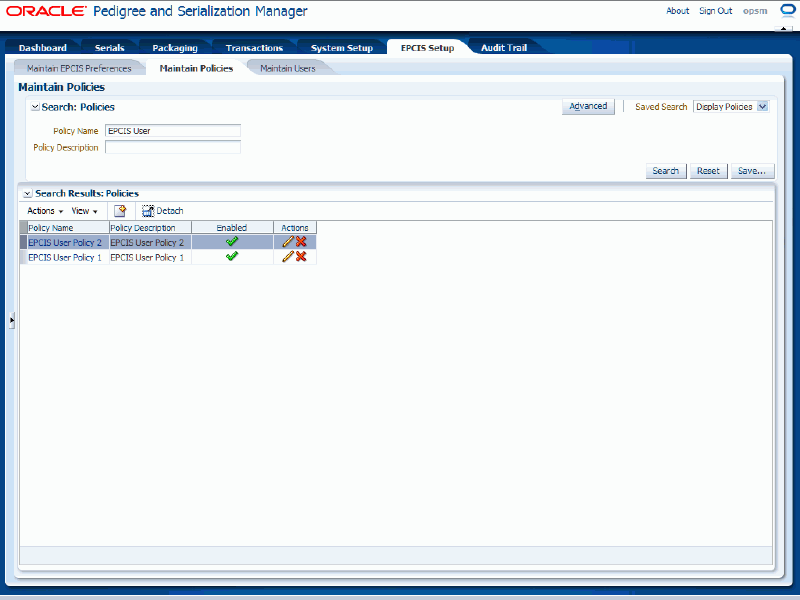
All of the policies that match the search criteria appear in the Search Results: Policies region in a table format.
Click the Advanced button to perform an advanced search.
To Search for Policies (Advanced Search)
Navigate to the Maintain Policies page.
Click the Advanced button.
Note: Clicking the Advanced or Basic button will keep the values in the base criteria fields.
Maintain Policies page (Advanced Search)
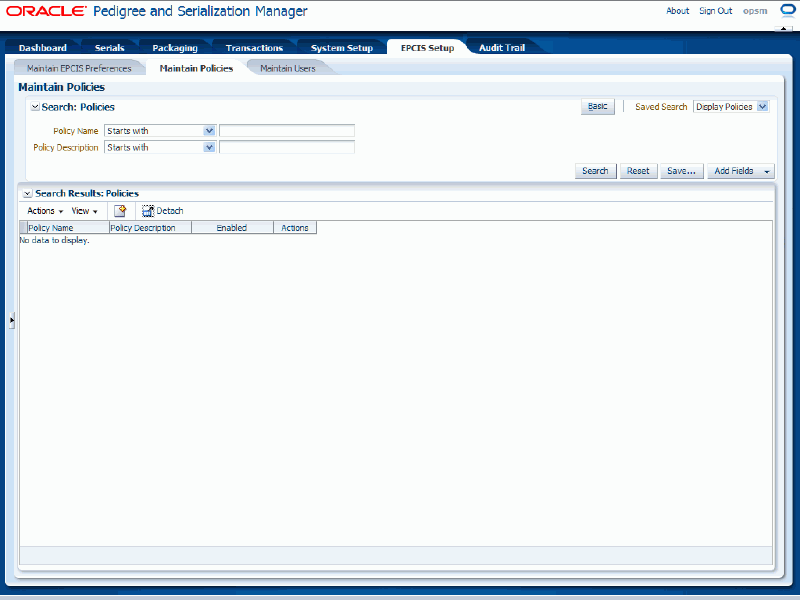
In the Search: Policies region, enter the search criteria for the policies using one or both of these fields:
| Field Name | Description |
|---|---|
| Policy Name | (Optional) Select the field operator and then enter the policy name. Operators are:
|
| Policy Description | (Optional) Select the field operator and then enter the policy description. The field operators are the same as that for the Policy Name field. |
Otherwise, you can click the Search button without entering any search criteria and all available policies will appear
(Optional) To enter additional search criteria fields, click the Add Fields button and select the field you would like to add to the search criteria.
The selected field appears as a search criteria field.
Note: To remove the additional field, click the Remove icon next to the field. The field will be removed from the search criteria.
(Optional) Enter search criteria for the additional fields.
Click the Search button.
Maintain Policies page (Advanced Search)
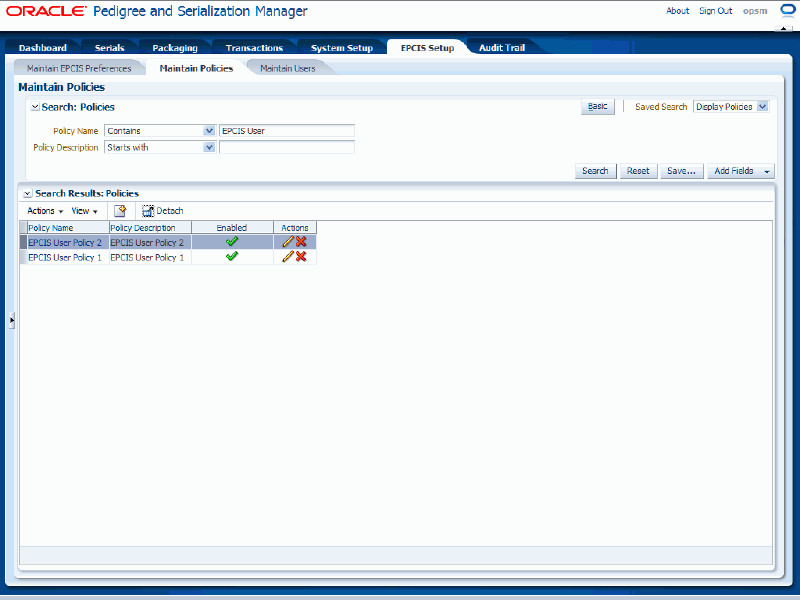
All of the policies that match the search criteria appear in the Search Results: Policies region in a table format.
Navigate to the Maintain Policies page.
Select Create from the Actions menu or click the Create Policy icon located at the top of the Search Results: Policies region.
Create Policy page
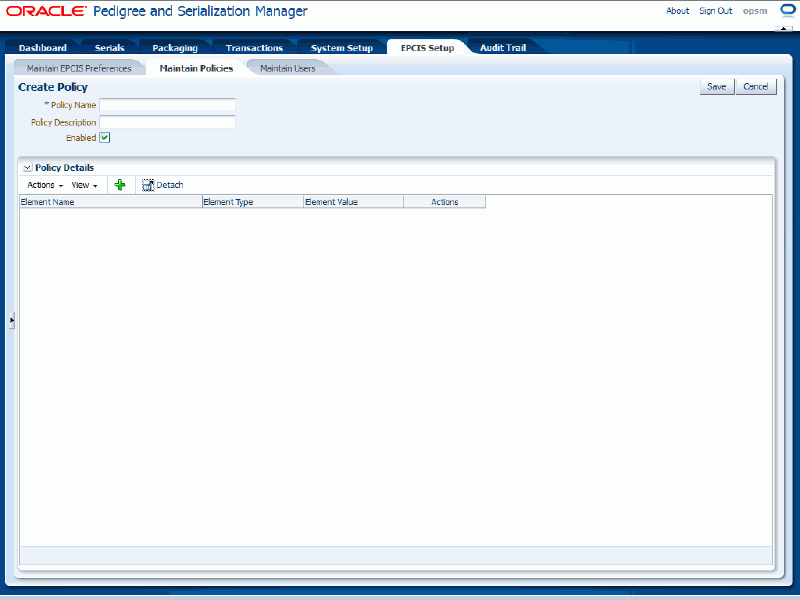
The Create Policy page appears.
Enter the following information:
| Field Name | Description |
|---|---|
| Policy Name | Enter the name of the policy. |
| Policy Description | (Optional) Enter a description of the policy. |
| Enabled check box | Select this check box to enable the policy for use. This check box appears selected by default. |
Create Policy page
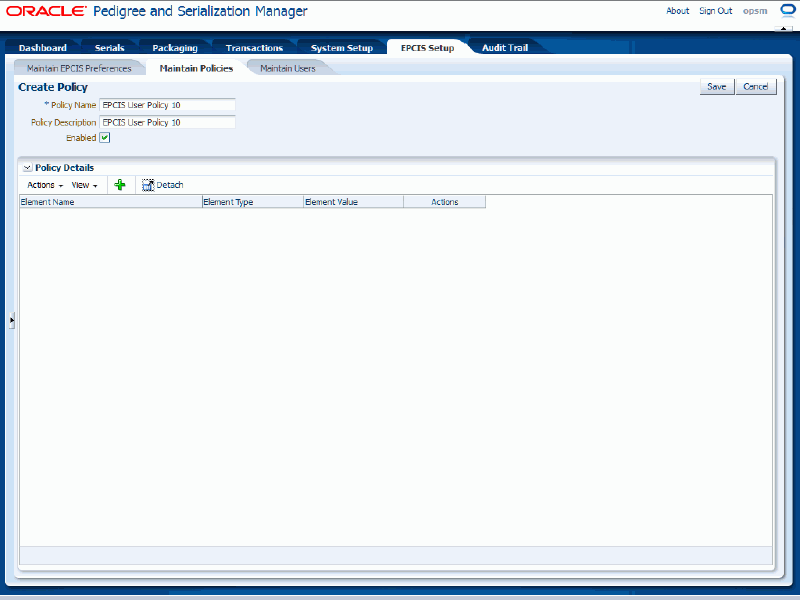
Add policy details.
Select Add from the Actions menu or click the Add Policy Element icon located at the top of the Policy Details region.
Create Policy page
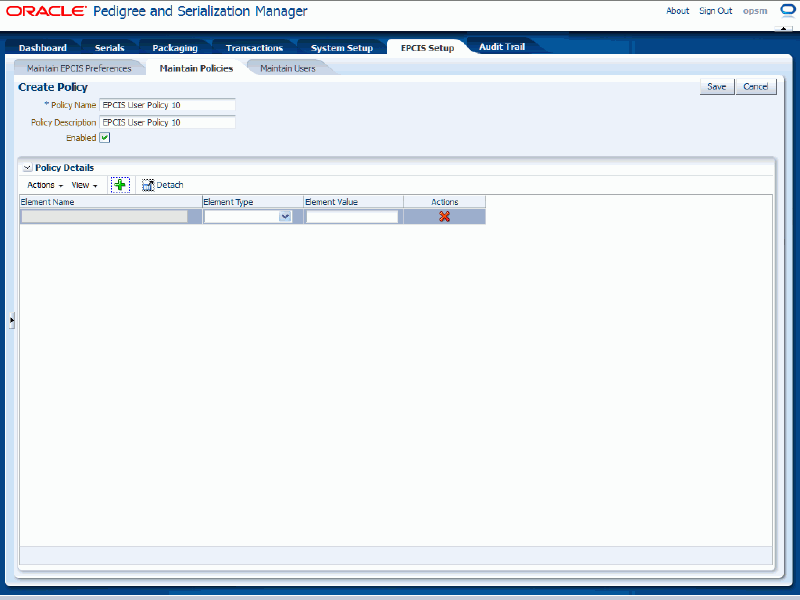
A new row appears in the Policy Details table.
Enter the following information:
| Field Name | Description |
|---|---|
| Element Name | The name of the element displays after you select an Element Type. You cannot update this field. |
| Element Type | Select the type of element you want to add to the policy. Element Types are:
|
| Element Value | Enter an element value. Values must be a 6-12 digit number or an asterisk (*). |
Create Policy page

Select the policy detail (Element Name, Element Type , and Element Value) that you want to delete in the table.
Select Delete from the Actions menu or click the Delete Policy icon associated with the policy detail in the Action column of the Policy Details table.
Click the Save button to save the policy and to return back to the Maintain Policies page.
Note: At least one Policy Detail record is required for each policy.
Navigate to the Maintain Policies page.
Enter search criteria for the policies you want to edit and click the Search button.
All of the policies that match the search criteria appear in the Search Results: Policies table.
Select the policy in the table that you want to edit.
Select Edit in the Actions menu or click the Edit Policy icon associated with the policy in the Actions column of the results table.
Edit Policy page
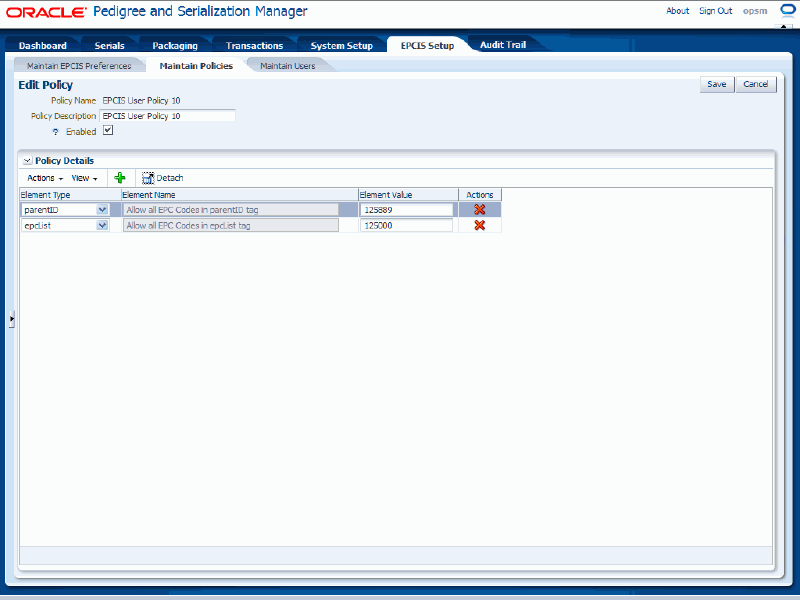
The Edit Policy page appears displaying all of the existing information for the policy.
Edit the policy.
Modify any of the existing details associated with the policy.
Edit Policy page

Select Add in the Actions menu or click the Add Policy Element icon located at the top of the Policy Details region.
Add the additional policy information.
Select Delete in the Actions menu or click the Delete Policy icon associated with a policy detail in the Actions column of the Policy Details table.
Click the Yes button to confirm
Click the Save button to save the changes you made to the policy information and to return back to the Maintain Policies page.
Note: At least one Policy Detail record is required for each policy.
Navigate to the Maintain Policies page.
Enter search criteria for the policies you want to delete and click the Search button.
All of the policies that match the search criteria appear in the Search Results: Policies table.
Note: You cannot delete a policy if it is associated to an EPCIS user. You will either need to delete the associated user or assign a new policy to the user and then you will able to delete the policy.
For more information on deleting users, see Maintaining Users.
Select the policy in the table that you want to delete.
Select Delete in the Actions menu or click the Delete Policy icon associated with the policy in the Actions column of the results table.
The system displays a message stating are you sure you want to delete this policy?
Click the Yes button.
The policy is deleted from the system.
Use the Maintain Users page to define the users and their associated EPCIS policies that are used by the EPCIS Query web service when querying the EPCIS repository. You only have to set up users if the Enable Oracle EPCIS Security check box is selected on the Maintain EPCIS Preferences page. These users are the external users who are attempting to access the EPCIS repository through the EPCIS Query web service.
Use these procedures to search (basic and advanced), create, edit, and delete users:
To Search for Users (Basic Search)
Navigate to the Maintain Users page.
Maintain Users page (Basic Search)

In the Search: Users region, enter the search criteria for the users using one or more of these fields:
| Field Name | Description |
|---|---|
| User Name | (Optional) Enter the user name. |
| User Description | (Optional) Enter the user description. |
| Applied Policy | (Optional) Enter the policy associated with the user. |
| Policy Description | (Optional) Enter the policy description for the policy associated with the user. |
Otherwise, you can click the Search button without entering any search criteria and all available users will appear.
Click the Search button.
Maintain Users page (Basic Search)
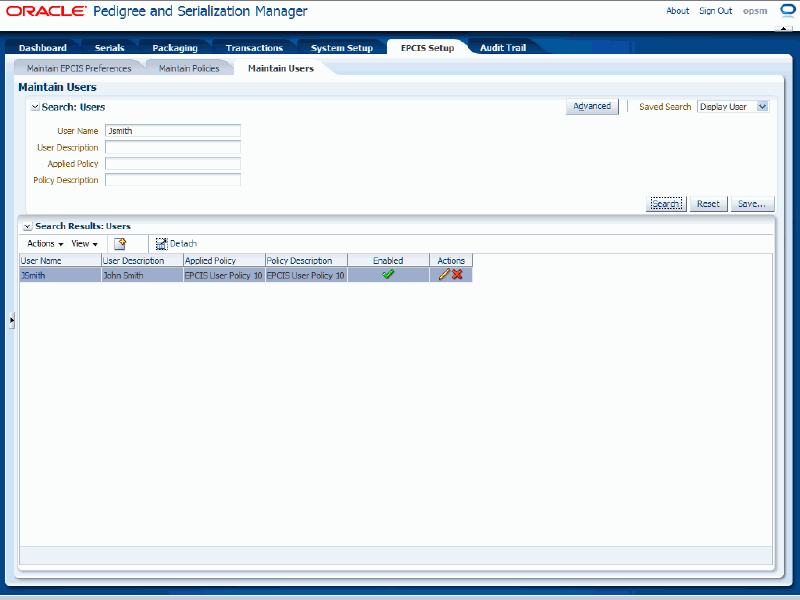
All of the users that match the search criteria appear in the Search Results: Users region in a table format.
Click the Advanced button to perform an advanced search.
To Search for Users (Advanced Search)
Navigate to the Maintain Users page.
Click the Advanced button.
Note: Clicking the Advanced or Basic button will keep the values in the base criteria fields.
Maintain Users page (Advanced Search)
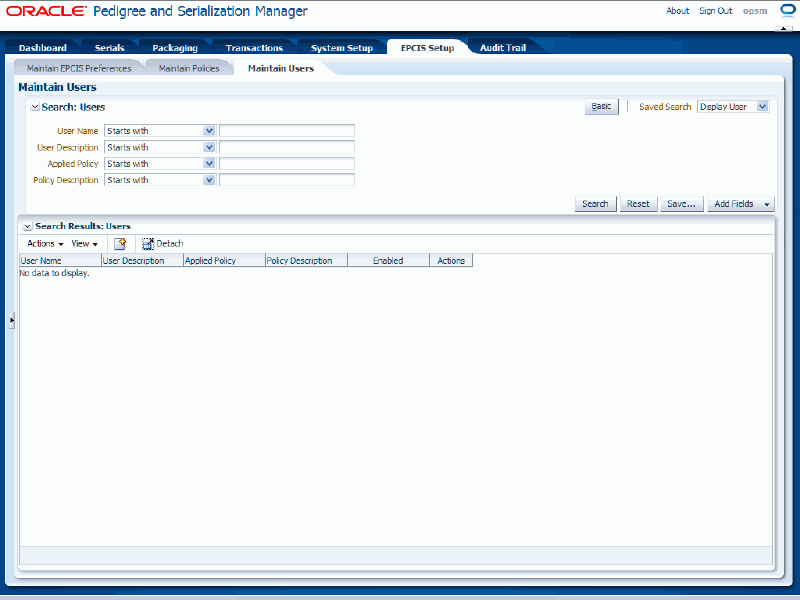
In the Search: Users region, enter the search criteria for the users using one or more of these fields:
| Field Name | Description |
|---|---|
| User Name | (Optional) Select the field operator and then enter the user name. Operators are:
|
| User Description | (Optional) Select the field operator and then enter the user description. The field operators are the same as that for the User Name field. |
| Applied Policy | (Optional) Select the field operator and then enter the policy associated with the user. The field operators are the same as that for the User Name field. |
| Policy Description | (Optional) Select the field operator and then enter the policy description for the policy associated with the user. The field operators are the same as that for the User Name field. |
Otherwise, you can click the Search button without entering any search criteria and all available users will appear.
(Optional) To enter additional search criteria fields, click the Add Fields button and select the field you would like to add to the search criteria.
The selected field appears as a search criteria field.
Note: To remove the additional field, click the Remove icon next to the field. The field will be removed from the search criteria.
(Optional) Enter search criteria for the additional fields.
Click the Search button.
Maintain Users page (Advanced Search)
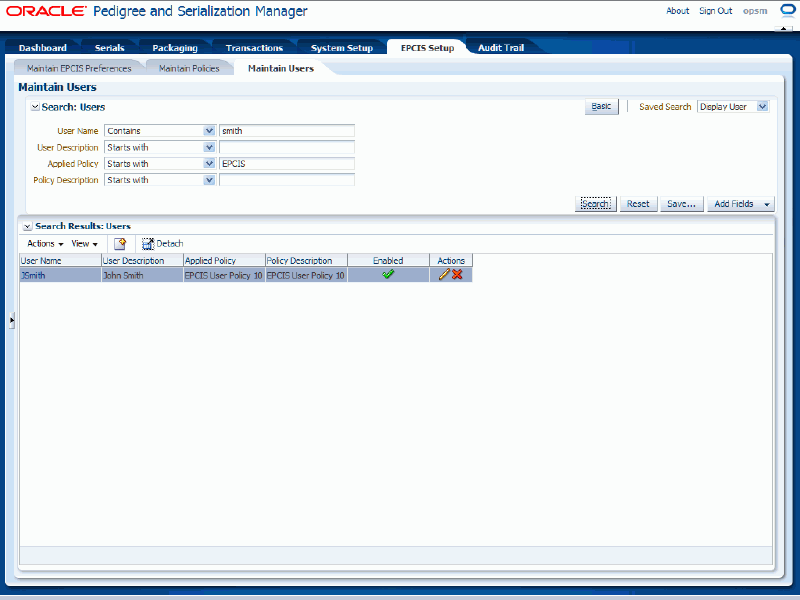
All of the policies that match the search criteria appear in the Search Results: Users region in a table format.
Navigate to the Maintain Users page.
Select Create from the Actions menu or click the Create icon located at the top of the Search Results: Users region.
Create User page

The Create User page appears.
Enter the following information:
| Field Name | Description |
|---|---|
| User Name | Enter the user name. |
| User Description | (Optional) Enter a user description. |
| Applied Policy | Select a policy to associate with the user.
Note: You can't associate a disabled policy to a user, and disabled policies do not display in the search and select. For information on maintaining policies, see Maintaining Policies. |
| Enabled check box | Select this check box if the user is enabled. The check box is selected by default. If the user is not enabled, the security validation for EPCIS Query will fail and no data will be returned. |
Create User page

Click the Save button to save the user and return back to the Maintain Users page.
Navigate to the Maintain Users page.
Enter search criteria for the users that you want to edit and click the Search button.
All of the users that match the search criteria appear in the Search Results: Users table.
Select the user in the table that you want to edit.
Select Edit in the Actions menu or click the Edit User icon associated with the user in the Actions column of the results table.
Edit User page
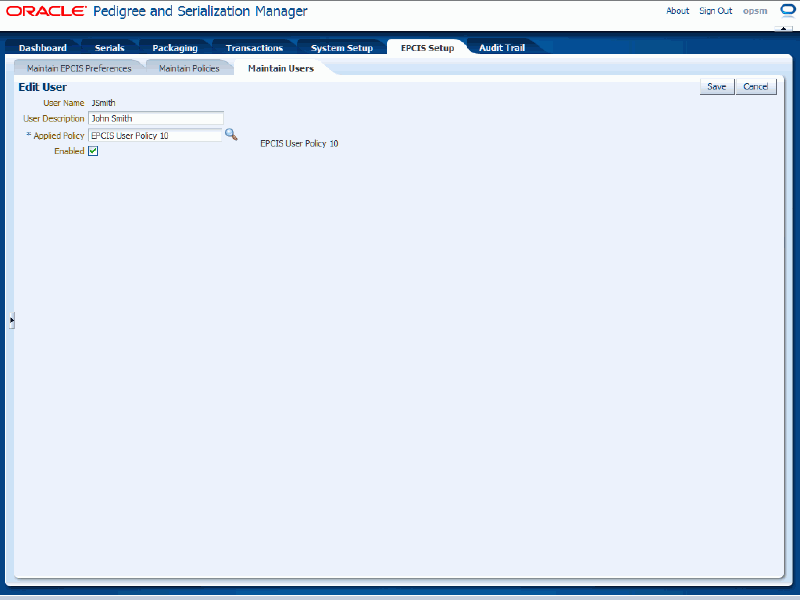
The Edit User page appears displaying all of the existing information for the user.
Modify any of the existing details associated with the user.
Edit User page
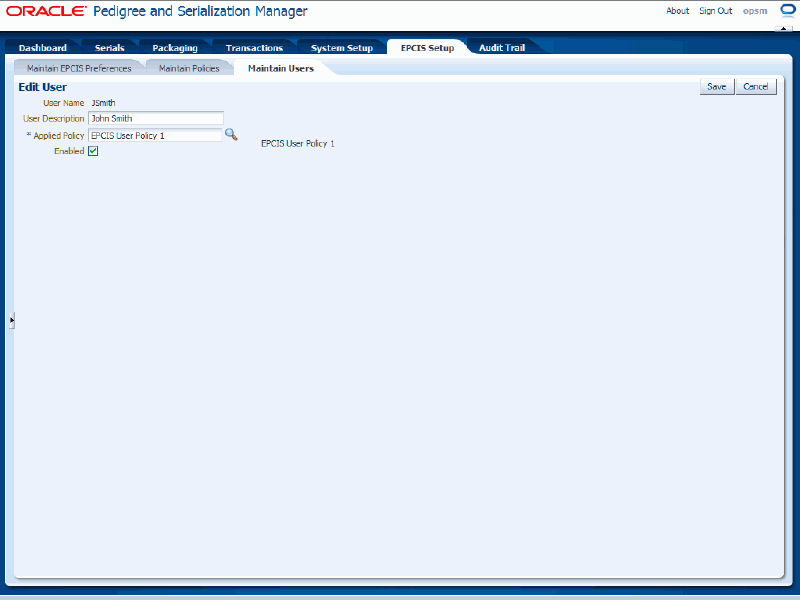
Click the Save button to save the changes you made to the user information and to return back to the Maintain Users page.
Navigate to the Maintain Users page.
Enter search criteria for the users you want to delete and click the Search button.
All of the users that match the search criteria appear in the Search Results: Users table.
Select the user in the table that you want to delete.
Select Delete in the Actions menu or click the Delete User icon associated with the user in the Actions column of the results table.
The system displays a message stating are you sure you want to delete this user?
Click the Yes button.
The user is deleted from the system.
![]()
Copyright © 2013, Oracle and/or its affiliates. All rights reserved.